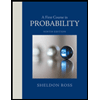
A First Course in Probability (10th Edition)
10th Edition
ISBN: 9780134753119
Author: Sheldon Ross
Publisher: PEARSON
expand_more
expand_more
format_list_bulleted
Question
![**Probability Calculation in a Normal Distribution**
**Problem:**
Suppose \( x \) is a normally distributed random variable with mean \( \mu = 0 \) and standard deviation \( \sigma = 1 \). Find the probability that \( x < 0.64 \).
**Options:**
- \( 26.11\% \)
- \( 76.11\% \)
- \( 23.89\% \)
- \( 73.89\% \)
**Explanation:**
To find the probability \( P(x < 0.64) \) when \( x \) follows a normal distribution with a mean \( \mu = 0 \) and standard deviation \( \sigma = 1 \), one would typically use a standard normal distribution table (Z-table) or statistical software.
1. **Standardize the variable:** Convert the value \( 0.64 \) to a Z-score using the formula:
\[ Z = \frac{X - \mu}{\sigma} \]
Since \( \mu = 0 \) and \( \sigma = 1 \):
\[ Z = \frac{0.64 - 0}{1} = 0.64 \]
2. **Consult the Z-table:** Locate the Z-score (0.64) in the Z-table to find the corresponding cumulative probability.
Based on standard Z-tables, the cumulative probability for \( Z = 0.64 \) is approximately \( 0.7389 \).
Therefore, the probability \( P(x < 0.64) \) is:
\[ P(x < 0.64) = 0.7389 \]
or \( 73.89\% \).
Hence, the correct option is:
- \( 73.89\% \)](https://content.bartleby.com/qna-images/question/c9d14dc9-6899-40d3-8d6b-066b6648b231/cb6e697c-ed74-4906-9e49-90ea7538a99c/uv6ceil_thumbnail.png)
Transcribed Image Text:**Probability Calculation in a Normal Distribution**
**Problem:**
Suppose \( x \) is a normally distributed random variable with mean \( \mu = 0 \) and standard deviation \( \sigma = 1 \). Find the probability that \( x < 0.64 \).
**Options:**
- \( 26.11\% \)
- \( 76.11\% \)
- \( 23.89\% \)
- \( 73.89\% \)
**Explanation:**
To find the probability \( P(x < 0.64) \) when \( x \) follows a normal distribution with a mean \( \mu = 0 \) and standard deviation \( \sigma = 1 \), one would typically use a standard normal distribution table (Z-table) or statistical software.
1. **Standardize the variable:** Convert the value \( 0.64 \) to a Z-score using the formula:
\[ Z = \frac{X - \mu}{\sigma} \]
Since \( \mu = 0 \) and \( \sigma = 1 \):
\[ Z = \frac{0.64 - 0}{1} = 0.64 \]
2. **Consult the Z-table:** Locate the Z-score (0.64) in the Z-table to find the corresponding cumulative probability.
Based on standard Z-tables, the cumulative probability for \( Z = 0.64 \) is approximately \( 0.7389 \).
Therefore, the probability \( P(x < 0.64) \) is:
\[ P(x < 0.64) = 0.7389 \]
or \( 73.89\% \).
Hence, the correct option is:
- \( 73.89\% \)
Expert Solution
This question has been solved!
Explore an expertly crafted, step-by-step solution for a thorough understanding of key concepts.
Step by stepSolved in 4 steps with 1 images

Knowledge Booster
Similar questions
- Assume the random variable X is normally distributed with mean μ=50 and standard deviation σ=7. Find the 77th percentile. The 77thpercentile is:arrow_forwardA person's blood glucose level and diabetes are closely related. Let x be a random variable measured in milligrams of glucose per deciliter (1/10 of a liter) of blood. Suppose that after a 12-hour fast, the random variable x will have a distribution that is approximately normal with mean u = 89 and standard deviation o = 27. Note: After 50 years of age, both the mean and standard deviation tend to increase. For an adult (under 50) after a 12-hour fast, find the following probabilities. (Round your answers to four decimal places.) n USE SALT (a) x is more than 60 (b) x is less than 110 (c) x is between 60 and 110 (d) x is greater than 125 (borderline diabetes starts at 125) Need Help? Watch It Read Itarrow_forwardSuppose x is a normally distributed random variable with mean u =0 and standard deviation o = 1. Find the probability that x < 0.64. O 73.89% 76.11% 23.89% O 26.11%arrow_forward
- When conducting research on allergic reactions to a new drug, a researcher forms random groups with five males in each group. The random variable x is the number of males in the group who develop an allergic reaction. x P(x) 0 0.665 1 0.278 2 0.052 3 0.004 4 0.001 5 0.000 a. Find its mean and standard deviation. (Round to one decimal place as needed) b. What is the probability of at least 3 males developing an allergic reaction? (Round to three decimal places as needed)arrow_forwardStorm damage can occur to homes in any given year, with the amount of damage varying randomly from year to year. Let X represent the dollar value of storm damage in a given year. It is known that in 95% of the years, X = $0, while in 5% of the years, X = $20,000. What is the expected value and standard deviation of the damage in any given year?arrow_forwardUse the z formula and the normal table( z distribution) to solve the following problems. the time it takes a person to lose weight following a healthy diet with regular exercise may be looked upon as a random variable having a normal distribution with mean μ = 18.4 lbs per month and standard deviation σ = 5.8 lbs per month. Find the probabilities that during a period of healthy dieting and exercising a person's weight will be reduced by at least 20 lbs per month,between 5 and 15 lbs per month,at most 30 lbs per month and between 15 and 25 lbs per month?arrow_forward
- Assume the random variable x is normally distributed with mean μ=80 and standard deviation σ=5. Find the indicated probability. P(66<x<70)arrow_forwardlevel of blood glucose and diabetes are closoly related. Let x bo a random variable measured in milligrams of glucose per deciliter of od. After a 12-hour fast, th random variable x will have a distribution that is approximately normal with mean - 85 and standard deviation 5. What is the probability that for an adult after a 12-hour fast. s less than 7o, b. x is greater than 120?arrow_forwardAssume the random variable x is normally distributed with mean = 88 and standard deviation a = 4. Find the indicated probability. P(75 <x < 83)arrow_forward
arrow_back_ios
arrow_forward_ios
Recommended textbooks for you
 A First Course in Probability (10th Edition)ProbabilityISBN:9780134753119Author:Sheldon RossPublisher:PEARSON
A First Course in Probability (10th Edition)ProbabilityISBN:9780134753119Author:Sheldon RossPublisher:PEARSON

A First Course in Probability (10th Edition)
Probability
ISBN:9780134753119
Author:Sheldon Ross
Publisher:PEARSON
